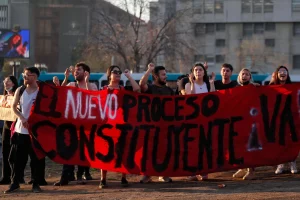On June 24, around two thousand migrants attempted to climb the fence that separates Morocco from Melilla (Spain’s north African enclave). This resulted in a clash between the Moroccan police and the migrants, as the police used tear gas and batons on them. Spanish border guards also played a role in the incident as they surrounded those who had managed to cross the border into Melilla and pushed them back. The exact number of deaths is not certain. According to Moroccan authorities, 23 people died. However, according to Amnesty International, at least 37 people died.
Spain has two enclaves that border Morocco: Melilla and Ceuta. Despite the fact that the borders are separated by barbed wires, fences, and border guards, these two enclaves have become crossing points for migrants who hope to reach Europe. According to official numbers provided by Anadolu Agency, a Turkish news agency, the border guards stopped more than 14,700 individuals attempting to enter Spanish territory in the first quarter of 2022.
What has been the international response?
Spanish Prime Minister, Pedro Sánchez, gave a speech on June 24 explaining that the Moroccan authorities had only been doing their job and he praised their efforts saying that they had to respond to a “violent and organized” assault. However, after some videos of the assault were released, Sánchez distanced himself from his statement He subsequently explained that he was not aware of all that had happened when he gave his speech and that he had not previously seen any images and videos.
Since then, there have been three separate investigations. The first one is led by the public prosecutor’s office in Nado, the second by the Spanish attorney general’s office, and the last by the Spanish ombudsman’s office.
Moroccan authorities have prosecuted various individuals who were involved in the crossing. In July, 33 migrants involved in the initial crossing were sentenced to 11 months in prison. The stated reason for the sentencing was that the migrants had illegally entered another territory. Furthermore, in August, the Moroccan authorities fined 13 Sudanese and Chadian migrants and sentenced them to two and a half years in prison. The Moroccan National Council on Human Rights (CNDH) did an investigation and explained that the deaths were caused by people suffocating as they tried to cross the fence. They also stated that Moroccan security forces did not systematically use violence against the migrants. According to the Council, they only used violence in cases where the migrants carried stones and sticks.
Soon after the incident, on July 18, the United Nations called for an independent investigation into this “gravely concerning” event. The UN International Independent Expert Mechanism (IIEM) is looking for information on the incident from the governments of Spain and Morocco in efforts to advance racial justice. Additionally, the experts have asked to be provided with information on the domestic regulation of the use of force to make sure a similar incident does not happen again. One of the aims of this investigation is to make sure that both countries are held accountable for their actions and provide the necessary reparations for victims. The UN is not the only international organization that is looking into the incident. Indeed, soon after the event, the African Union Commission (AUC) also asked for an investigation to be conducted.
Why is this affair resurfacing in the press now?
On November 29, a report on a joint investigation led by El País, Lighthouse Reports, Le Monde, Der Spiegel, and Enass on the incident was published. During this investigation, investigators analyzed around 140 videos of the event, conducted 40 interviews with migrants who tried to cross the fence, and even created a three-dimensional reconstruction of the border. The investigation concluded that the border guards of both countries abandoned people who were in need of help. On one hand, they explain that Moroccan officers were firing tear gas even though people were in a dead-end compound. The report also explained that they responded with brutality. On the other hand, the investigation reveals that the Spanish border guards did not provide assistance to the victims. In fact, the person interviewed said that they saw a migrant die on the Spanish side of the border.
More recently, on December 13, Amnesty International published an article accusing both countries of stalling the investigation. The international organization has stated that both governments have so far not managed to provide effective and transparent investigations. Furthermore, since the incident, some individuals have gone missing and their families have not been kept informed about the situation. Amnesty International’s Secretary General, Agnès Callamard, states that six months have passed since the crossing and neither government has taken responsibility. She also noted that there is a growing amount of evidence that points to human rights violations such as the “ill-treatment of refugees.”
In the last few weeks, both governments have experienced an increase in attention from the press, as well as from NGOs, international organizations, and regional organizations. This unwanted attention should push both governments to make the results of the investigations more transparent and incentive them to prevent such an incident from happening again.
Cover photo by: The Associated Press






